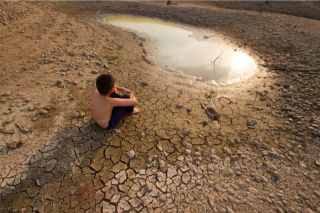
www.buildingsandcities.org/insights/commentaries/cop26-children.html
Trust and Empower the World's Schoolchildren

By Robin Nicholson CBE (Cullinan Studio and The Edge, UK)
Personal experience as a construction professional and an expert advisor to client organisations and to government has shown how slow top-down approaches can sometimes be to create change. In contrast, a bottom-up approach can result in rapid and strong change. An example of young schoolchildren being empowered to reduce their school's energy demand has yielded astonishing results. The climate emergency is an intergenerational issue that will dramatically affect the younger generation. Involving childen and harnessing their positive approach is an imperative to constructive change.
COP-26 will fly hordes of the powerful and rich to Glasgow to meet with some of the less rich in (another) last chance programme to save the planet. There will be specialists from the IPCC, academics and NGOs. We experts know what must be done for mitigation and adaptation. If it is all so clear, why haven't we changed our habits as a well-informed industry, city or country? Why is there no popular uprising about the way we waste energy; could it be that we experts enjoy talking to ourselves?
Re-reading Meadows' (1999) seminal Leverage Points reminds me of our need for some humility. She quotes Jay Forrester as reporting: "People know intuitively where the leverage points are. Time after time I've done an analysis of a company, and I've figured out a leverage point … Then I've gone to the company and discovered that there's already a lot of attention to that point. Everyone is trying very hard to push it in the wrong direction." Her sixth leverage point 'The Structure of Information Flows' notes the lower consumption of electricity by those whose meter is in the hall as opposed to their basement.
We experts design and manage the public school estate to provide adequate if not excellent spaces for the benefit of our children and their collective futures. But, despite our best efforts, we aren't well practiced in systems thinking so we make decisions like teachers wanting to teach and not worry about opening windows to modify the temperature. Consequently, many classrooms overheat. Recently, recorded temperatures of 41 oC were found in classrooms in a London school as a result of a series of unconnected changes to the classrooms which had built up to this illegal condition. Fortunately, the team of architects and engineers were able to rectify this relatively easily. A systems approach might lead us to realise that the school pupils around the globe could be those best placed to monitor the school and to benefit from the understanding through so doing. However, as a society and professionals we seem to be more comfortable with top-down approaches - which can be problematic as the example below demonstrates.
Back in January 2010, the UK Secretary of State at Department for Children Schools and Families, Ed Balls, accepted the recommendations of the Final Report of the Zero Carbon Task Force that I had the privilege to chair. The Task Force had been set up to advise Government how they could ensure that all new schools would be Carbon Neutral by 2016. Rather than adopting a technical solution, we followed the recommendation of Task Force member Bill Bordass that schools should "Halve the demand, double the efficiency and halve the carbon in the supply and you are down to one eighth of the emissions." Back then it seemed the only difficult part was halving the carbon in the supply which is the only part that has actually been achieved. All 29 recommendations were adopted and a contract let for the free installation of display meters in every school that wanted one.
However, change is not straightforward. Following the change of UK Government in May 2010, the Zero Carbon Schools programme was abandoned, and the meter contract cancelled. This echoes precisely what Meadows described about pushing in the wrong direction. Eleven years later in 2021, the UK Government is resetting the targets to reduce carbon emissions by 78% by 2035 (less reduction and a longer time scale than in 2010) and the Department of Education has launched a Schools Energy Retrofit Pathfinder Programme. Meanwhile the school pupils' Teach the Future: Campaign for climate education has recently made its submission for all schools to be Net Zero by 2030 and for the climate emergency and ecological crisis to be embedded in the curriculum, with reference to our 2010 Report.
An astonishingly positive and rapid example of change is a bottom-up approach. My visit to Ashley Church of England Primary School in Woking (UK) showed what is possible. The Head had grasped the climate challenge, installed a display meter in the front hall and put the children in charge of reducing the electricity consumption. With daily monitoring and weekly reporting to the whole school the energy team were offered £10 to go into a special projects fund if they kept the consumption below 100kWh/day for a week. In the first year they reduced consumption by over 50% and by over 80% after three years.The curriculum was developed to ensure that the data was used in their science and maths studies.One unexpected outcome was that the pupils took their interest and enthusiasm home and some of the parents then set up a club for those who could keep their consumption below 100kWhr/week - some leverage! Donatella Meadows would be proud of their achievements. Systems thinking really works.
This is the moment for the politicians and experts at COP-26 to engage the widest population and to embrace school pupils as willing and able agents of change. It is their future that we are jeopardising. School pupils understand the climate challenge and its potential impact on their lives.More significantly, they have demonstrated that they can create positive change quickly and effectively. They are motivated and open to change. My expectation for COP-26 is that in addition to governments committing to clearly defined pathways and programmes to decarbonise, that we empower schoolchildren to help us make this transition.
References
Meadows, Donella H. (1999). Leverage Points: Places to Intervene in the System. Hartland, VT: The Sustainability Institute. http://www.donellameadows.org/wp-content/userfiles/Leverage_Points.pdf
Zero Carbon Task Force. (2010). The Road to Zero Carbon (final report. London: Department for Children Schools and Families. https://dera.ioe.ac.uk/672/1/00111-2010DOM-EN.pdf/
Latest Peer-Reviewed Journal Content
A framework for 1.5°C-aligned GHG budgets in architecture
G Betti, I Spaar, D Bachmann, A Jerosch-Herold, E Kühner, R Yang, K Avhad & S Sinning
Net zero retrofit of the building stock [editorial]
D Godoy-Shimizu & P Steadman
Co-learning in living labs: nurturing civic agency and resilience
A Belfield
The importance of multi-roles and code-switching in living labs
H Noller & A Tarik
Researchers’ shifting roles in living labs for knowledge co-production
C-C Dobre & G Faldi
Increasing civic resilience in urban living labs: city authorities’ roles
E Alatalo, M Laine & M Kyrönviita
Co-curation as civic practice in community engagement
Z Li, M Sunikka-Blank, R Purohit & F Samuel
Preserving buildings: emission reductions from circular economy strategies in Austria
N Alaux, V Kulmer, J Vogel & A Passer
Urban living labs: relationality between institutions and local circularity
P Palo, M Adelfio, J Lundin & E Brandão
Living labs: epistemic modelling, temporariness and land value
J Clossick, T Khonsari & U Steven
Co-creating interventions to prevent mosquito-borne disease transmission in hospitals
O Sloan Wood, E Lupenza, D M Agnello, J B Knudsen, M Msellem, K L Schiøler & F Saleh
Circularity at the neighbourhood scale: co-creative living lab lessons
J Honsa, A Versele, T Van de Kerckhove & C Piccardo
Positive energy districts and energy communities: how living labs create value
E Malakhatka, O Shafqat, A Sandoff & L Thuvander
Built environment governance and professionalism: the end of laissez-faire (again)
S Foxell
Co-creating justice in housing energy transitions through energy living labs
D Ricci, C Leiwakabessy, S van Wieringen, P de Koning & T Konstantinou
HVAC characterisation of existing Canadian buildings for decarbonisation retrofit identification
J Adebisi & J J McArthur
Simulation and the building performance gap [editorial]
M Donn
Developing criteria for effective building-sector commitments in nationally determined contributions
P Graham, K McFarlane & M Taheri
Reimagining circularity: actions for optimising the use of existing buildings
R Lundgren, R Kyrö, S Toivonen & L Tähtinen
Effective interdisciplinary stakeholder engagement in net zero building design
S Vakeva-Baird, F Tahmasebi, JJ Williams & D Mumovic
Metrics for building component disassembly potential: a practical framework
H Järvelä, A Lehto, T Pirilä & M Kuittinen
The unfitness of dwellings: why spatial and conceptual boundaries matter
E Nisonen, D Milián Bernal & S Pelsmakers
Environmental variables and air quality: implications for planning and public health
H Itzhak-Ben-Shalom, T Saroglou, V Multanen, A Vanunu, A Karnieli, D Katoshevski, N Davidovitch & I A Meir
Exploring diverse drivers behind hybrid heating solutions
S Kilpeläinen, S Pelsmakers, R Castaño-Rosa & M-S Miettinen
Urban rooms and the expanded ecology of urban living labs
E Akbil & C Butterworth
Living with extreme heat: perceptions and experiences
L King & C Demski
A systemic decision-making model for energy retrofits
C Schünemann, M Dshemuchadse & S Scherbaum
Modelling site-specific outdoor temperature for buildings in urban environments
K Cebrat, J Narożny, M Baborska-Narożny & M Smektała
Understanding shading through home-use experience, measurement and modelling
M Baborska-Narożny, K Bandurski, & M Grudzińska
Building performance simulation for sensemaking in architectural pedagogy
M Bohm
Beyond the building: governance challenges in social housing retrofit
H Charles
Heat stress in social housing districts: tree cover–built form interaction
C Lopez-Ordoñez, E Garcia-Nevado, H Coch & M Morganti
An observational analysis of shade-related pedestrian activity
M Levenson, D Pearlmutter & O Aleksandrowicz
Learning to sail a building: a people-first approach to retrofit
B Bordass, R Pender, K Steele & A Graham
Market transformations: gas conversion as a blueprint for net zero retrofit
A Gillich
Resistance against zero-emission neighbourhood infrastructuring: key lessons from Norway
T Berker & R Woods
Megatrends and weak signals shaping future real estate
S Toivonen
A strategic niche management framework to scale deep energy retrofits
T H King & M Jemtrud
Generative AI: reconfiguring supervision and doctoral research
P Boyd & D Harding
Exploring interactions between shading and view using visual difference prediction
S Wasilewski & M Andersen
How urban green infrastructure contributes to carbon neutrality [briefing note]
R Hautamäki, L Kulmala, M Ariluoma & L Järvi
Implementing and operating net zero buildings in South Africa
R Terblanche, C May & J Steward
Quantifying inter-dwelling air exchanges during fan pressurisation tests
D Glew, F Thomas, D Miles-Shenton & J Parker
Western Asian and Northern African residential building stocks: archetype analysis
S Akin, A Eghbali, C Nwagwu & E Hertwich
Join Our Community

The most important part of any journal is our people – readers, authors, reviewers, editorial board members and editors. You are cordially invited to join our community by joining our mailing list. We send out occasional emails about the journal – calls for papers, special issues, events and more.
We will not share your email with third parties. Read more



Latest Commentaries
COP30 Report
Matti Kuittinen (Aalto University) reflects on his experience of attending the 2025 UN Conference of the Parties in Belém, Brazil. The roadmaps and commitments failed to deliver the objectives of the 2025 Paris Agreement. However, 2 countries - Japan and Senegal - announced they are creating roadmaps to decarbonise their buildings. An international group of government ministers put housing on the agenda - specifying the need for reduced carbon and energy use along with affordability, quality and climate resilience.
Building-Related Research: New Context, New Challenges
Raymond J. Cole (University of British Columbia) reflects on the key challenges raised in the 34 commissioned essays for Buildings & Cities 5th anniversary. Not only are key research issues identified, but the consequences of changing contexts for conducting research and tailoring its influence on society are highlighted as key areas of action.